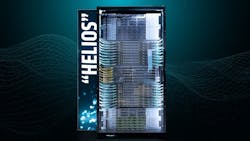AMD Scales the AI Factory: 6 GW OpenAI Deal, Korean HBM Push, and Helios Debut
Key Highlights
- OpenAI and AMD plan to deploy up to 6 GW of GPU compute capacity, starting with 1 GW in 2026, driven by next-generation Instinct MI450 accelerators.
- The partnership includes a warrant for AMD shares, potentially representing 10% of AMD's shares, aligning long-term interests and revenue growth prospects.
- AMD's Helios rack system exemplifies open standards, supporting high-density, liquid-cooled AI infrastructure with exascale capabilities, targeted for deployment in 2026.
- Strategic partnerships in Korea with Samsung and SK Group aim to expand high-bandwidth memory supply, critical for large-scale AI GPU deployments.
- The collaboration signals a shift towards open hardware ecosystems, diversifying supply chains and fostering innovation in AI data center design.
OpenAI and AMD have announced a multi-year, multi-generation partnership focused on deploying up to 6 gigawatts (GW) of GPU compute capacity, beginning with an initial 1 GW phase powered by AMD’s next-generation Instinct MI450 accelerators in the second half of 2026.
As part of the agreement, OpenAI received a warrant for up to 160 million AMD shares at $0.01 per share, vesting upon key deployment milestones through October 2030. If fully exercised, the warrant would represent roughly 10% of AMD’s current outstanding shares. AMD estimates the collaboration could generate tens of billions in annual revenue over time, with as much as $100 billion cumulatively tied to this and related hyperscale customers.
The deal establishes AMD as OpenAI’s second primary GPU supplier, alongside Nvidia, reinforcing OpenAI’s drive to secure “as much compute as we can possibly get.” AMD’s accelerators are widely recognized for their superior performance-per-watt efficiency, even if they do not yet surpass Nvidia’s top-end GPUs in absolute performance. Investor sentiment reflected the magnitude of the announcement: AMD shares surged more than 20% following the news.
In an interview with CNBC, Nvidia CEO Jensen Huang described his reaction to the deal: "It’s imaginative, it’s unique and surprising, considering they were so excited about their next generation product.” And on the issue of OpenAI getting an equity stake in AMD: “I’m surprised that they would give away 10% of the company before they even built it. And so anyhow, it’s clever, I guess."
With the equity stake tying OpenAI more closely to AMD, the long-term partnership positions AMD to benefit from a substantial and sustained customer relationship that could accelerate its GPU development roadmap.
What 6 GW of GPUs Really Means
The 6 GW of accelerator load envisioned under the OpenAI–AMD partnership will be distributed across multiple hyperscale AI factory campuses. If OpenAI begins with 1 GW of deployment in 2026, subsequent phases will likely be spread regionally to balance supply chains, latency zones, and power procurement risk.
Importantly, this represents entirely new investment in both power infrastructure and GPU capacity. OpenAI and its partners have already outlined multi-GW ambitions under the broader Stargate program; this new initiative adds another major tranche to that roadmap.
Designing for the AI Factory Era
These upcoming facilities are being purpose-built for next-generation AI factories, where MI450-class clusters could drive rack densities exceeding 100 kW. That level of compute concentration makes advanced power and cooling architectures mandatory, not optional. Expected solutions include:
- Warm-water liquid cooling (manifold, rear-door, and CDU variants) as standard practice.
- Facility-scale water loops and heat-reuse systems—including potential district-heating partnerships where feasible.
- Medium-voltage distribution within buildings, emphasizing busway-first designs and expanded fault-current engineering.
While AMD has not yet disclosed thermal design power (TDP) specifications for the MI450, a 1 GW campus target implies tens of thousands of accelerators. That scale assumes liquid cooling, ultra-dense racks, and minimal network latency footprints, pushing architectures decisively toward an “AI-first” orientation.
Design considerations for these AI factories will likely include:
- Liquid-to-liquid cooling plants engineered for step-function capacity adders (200–400 MW blocks).
- Optics-friendly white space layouts with short-reach topologies, fiber raceways, and aisles optimized for module swaps.
- Substation adjacency and on-site generation envelopes negotiated during early land-banking phases.
Networking, Memory, and Power Integration
As compute density scales, networking and memory bottlenecks will define infrastructure design. Expect fat-tree and dragonfly network topologies, 800 G–1.6 T interconnects, and aggressive optical-module roadmaps to minimize collective-operation latency, aligning with recent disclosures from major networking vendors.
HBM [High Bandwidth Memory] supply will become existential: every top-tier GPU depends on it. AMD’s deal rests on assured HBM volume, and Samsung’s recent capacity expansions point to an industry racing to meet that demand.
Finally, powering these campuses will require hybridized energy strategies, combining grid interconnects with on-site fast-start turbines, H₂-ready fuel cells, and battery energy storage systems (BESS) for ride-through and peak-shaving. Developers will need to address local interconnection and permitting challenges upfront to meet these enormous load requirements.
Are There Implications for the Data Center Industry?
OpenAI’s addition of AMD as a true gigawatt-scale GPU supplier will ripple through the entire data center ecosystem, from hyperscale cloud platforms to colocation providers and boutique AI builders. Every segment will now face pressure to validate ROCm-native software stacks and consider dual-path accelerator SKUs.
While NVIDIA’s CUDA platform maintains a substantial developmental lead, OpenAI’s endorsement of AMD accelerators at this scale changes the incentive structure. A successful migration (or even partial diversification) away from CUDA dependence would strengthen buyer leverage on both pricing and lead times across the industry.
Software Maturity and Ecosystem Acceleration
To fully capitalize on MI450-class clusters, the supporting software ecosystem must mature rapidly. This means optimized ROCm environments, tuned PyTorch/XLA kernels, and mixed-precision graph compilers capable of overlapping compute and communication at scale. The OpenAI collaboration will accelerate this process, driving kernel-library refinement, collective communication tuning, and scheduler integration that enterprise adopters can inherit downstream.
For smaller or regional data center operators, that acceleration provides an important signal: AMD-based GPU infrastructure is becoming a practical, supportable alternative to NVIDIA, backed by ecosystem momentum rather than experimental interest.
Memory, Packaging, and the Bottleneck Ahead
Even with a broader field of GPU suppliers, HBM and advanced packaging remain the long pole in the tent. Production capacity for HBM3E and HBM4 will ultimately gate how quickly large-scale GPU deployments can materialize. OpenAI’s Samsung and SK Group partnerships, announced October 1, aim to mitigate that risk by expanding high-bandwidth memory output during the critical 2026–2028 build window: exactly when AMD’s first 1 GW phase is scheduled to come online.
Bottom Line for Builders and Operators
- Design now for MI450-class liquid cooling and 100–150 kW+ racks.
- Engineer around HBM constraints—plan staggered cluster ramps, test/soak environments, and flexible network fabrics.
- Diversify power supply through grid and on-site generation, medium-voltage (MV) distribution, and BESS for peak-shaving and micro-event coverage.
- Treat software as infrastructure: invest in ROCm performance engineering pipelines and view communication libraries as critical-path assets, not optional tools.
OpenAI × Samsung (and Korea) — The “Stargate Korea” Pillar
As part of its broader Stargate initiative, OpenAI has announced strategic partnerships in South Korea with Samsung and SK Group to expand global AI infrastructure and boost production of advanced memory components. The collaboration combines new AI data center capacity in Korea with scaled-up HBM and DRAM manufacturing, aligning with the nation’s ambition to become a top-three global AI power supported by national-level industrial policy.
The partnerships target the most acute bottleneck in AI compute scaling: high-bandwidth memory supply. Reports suggest aggressive wafer-start schedules designed to meet Stargate-scale buildout timelines, enabling a steadier flow of HBM components for training-class GPUs.
Industry sources also point to AI data center developments within Korea, including projects involving SK-affiliated operators, forming a Northeast Asia hub that co-locates compute, optics, and memory manufacturing. This regional concentration will reduce latency in component logistics and create a vertically aligned supply corridor from chip fabrication to deployment.
Through these partnerships, Korean vendors in memory, packaging, and optical interconnects gain tighter integration with OpenAI’s hardware roadmaps—a development that directly benefits AMD’s deployment strategy by stabilizing HBM supply for the critical 2026 and beyond window.
Ultimately, the Stargate Korea partnerships reinforce AMD’s emergence as a credible, scalable alternative to NVIDIA in large-scale AI compute and solidify OpenAI’s long-term global development roadmap.
AMD “Helios” and the Open Rack Future of AI Infrastructure
At the OCP Global Summit 2025 in San Jose, AMD publicly unveiled its first rack-scale AI reference system, the “Helios” platform, built entirely on Meta’s new Open Rack Wide (ORW) specification. The ORW standard, recently contributed to the Open Compute Project, defines an open, double-wide rack format optimized for the power, cooling, and serviceability requirements of next-generation AI systems.
With “Helios,” AMD extends its open-hardware philosophy from silicon to system to rack, offering a deployable design meant for the gigawatt-scale AI campuses now taking shape under initiatives such as Stargate. The system combines Instinct MI450 GPUs, EPYC CPUs, and Pensando DPUs within an open-fabric environment that supports DC-MHS, UALink, and Ultra Ethernet Consortium (UEC) architectures, making it one of the first fully interoperable rack-scale AI systems built to OCP standards.
“Open collaboration is key to scaling AI efficiently,” said Forrest Norrod, executive vice president and general manager of AMD’s Data Center Solutions Group. “With Helios, we’re turning open standards into real, deployable systems: combining AMD Instinct GPUs, EPYC CPUs, and open fabrics to give the industry a flexible, high-performance platform built for the next generation of AI workloads.”
Rack-Scale Design for Exascale AI
Each Helios rack centers on 72 Instinct MI450 GPUs, powered by AMD’s CDNA architecture and equipped with up to 432 GB of HBM4 memory per GPU and 19.6 TB/s of bandwidth. At full configuration, a single rack can deliver roughly 1.4 exaFLOPS (FP8) or 2.9 exaFLOPS (FP4) of theoretical compute, supported by 31 TB of total HBM4 and 1.4 PB/s of aggregate bandwidth.
AMD’s internal performance modeling projects up to a 36× performance improvement over previous generations and roughly 50 percent greater memory capacity than NVIDIA’s Vera Rubin system, metrics that underscore Helios’s role as a reference point for large-model training and inference.
Interconnect throughput reaches 260 TB/s scale-up and 43 TB/s Ethernet scale-out, ensuring coherent communication across GPUs, nodes, and racks. The double-wide ORW form factor also improves weight distribution and serviceability, integrating backside quick-disconnect liquid cooling for sustained thermal performance in racks exceeding 100 kW density.
Openness as Infrastructure Strategy
Beyond raw performance, Helios functions as a blueprint for ecosystem collaboration. OEMs and ODMs can adopt or extend the reference design, integrating AMD silicon with their own differentiated modules while maintaining interoperability. The approach reduces time-to-market, curbs fragmentation, and ensures that future AI systems can evolve without being locked into proprietary rack dimensions or closed network fabrics.
The open-rack initiative led by Meta and AMD also unites major industry groups around a shared vision of standardization. By aligning OCP, UALink, and UEC under a single rack-scale architecture, Helios effectively formalizes an open alternative to vertically integrated AI systems - a move that could broaden participation across hyperscalers, sovereign cloud programs, and high-performance computing operators.
Power, Cooling, and 2026 Deployment Timeline
From a data-center design standpoint, Helios is built for the AI-era power envelope. The platform anticipates medium-voltage distribution, liquid-to-liquid heat-rejection loops, and BESS-integrated energy buffering as standard rack-row features. Its double-wide configuration allows higher thermal headroom per rack while simplifying maintenance and modular scaling: capabilities critical for 400-MW-plus campuses expected to come online later this decade.
AMD has begun releasing Helios as a reference platform to OEM and ODM partners, with volume deployments targeted for 2026. As those partners adapt the design to their own power and cooling topologies, Helios is poised to become a template for AI-factory buildouts worldwide, marrying open standards with the density and efficiency demanded by trillion-parameter models.
Why This Matters for Data Center Frontier Readers
For data-center developers and operators, Helios marks the convergence of open compute philosophy with practical rack-scale deployment. It exemplifies how AMD’s broader ecosystem strategy—spanning MI450 GPUs, ROCm software, HBM supply partnerships, and open power architectures—is coalescing into a coherent, scalable path for AI infrastructure.
In effect, Helios provides the industry’s clearest blueprint yet for how open standards, liquid-cooled racks, and multi-vendor fabrics will define the physical layer of the next generation of AI factories. For hyperscalers and colocation operators alike, the lesson is direct. Openness isn’t merely a philosophy; it’s rapidly becoming the engineering foundation for how the data center frontier expands.
At Data Center Frontier, we talk the industry talk and walk the industry walk. In that spirit, DCF Staff members may occasionally use AI tools to assist with content. Elements of this article were created with help from OpenAI's GPT5.
Keep pace with the fast-moving world of data centers and cloud computing by connecting with Data Center Frontier on LinkedIn, following us on X/Twitter and Facebook, as well as on BlueSky, and signing up for our weekly newsletters using the form below.
About the Author

David Chernicoff
Matt Vincent
A B2B technology journalist and editor with more than two decades of experience, Matt Vincent is Editor in Chief of Data Center Frontier.




